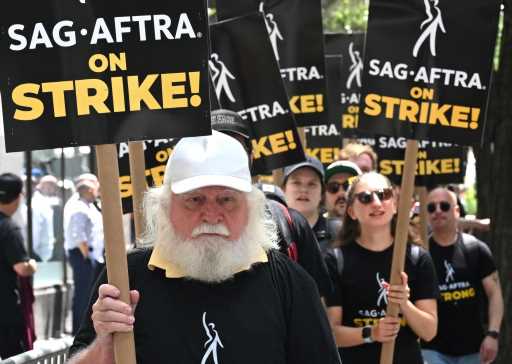SAG-AFTRA Strike “Much More Disruptive” To Media Biz Than WGA Walkout, Wall Street Analyst Says, Creating “Bad Combination” Of Production Halt, Weak Ad Market And “Poor PR”
While the 74-day-old WGA strike has been an “annoyance” for entertainment companies, in the view of one Wall Street analyst, the SAG-AFTRA walkout will be “much more disruptive.”
Related Stories
SAG-AFTRA Strike Photos: Actors Hit The Picket Lines On Day 1
SAG-AFTRA Tells Members Not To Bring Weapons To Picket Lines – Or Show Up Drunk Or Stoned
Tim Nollen, a veteran media analyst with Macquarie Equity Research, issued a note to clients today on the impact of the first strike by writers and actors since 1960. Media and tech stocks have pulled back a bit today, with Disney and Netflix shares off 2% and Comcast down 1%, but overall share prices and broader markets are not yet showing any severe reaction to the picketing. That could change in the trading days to come, Nollen predicts.
“Now, TV and movie filming grinds to a halt,” the analyst wrote. “Pay including royalties, working conditions including benefits, and terms around the use of generative AI are the sticking points, driven by wholesale changes that streaming has wrought in content production and consumption — writers and actors are often paid a lump sum only for the show, not for residuals, like windowing of linear TV or box office films. The timing will affect many of this coming season’s scheduled scripted dramas on TV, which may ironically drive even more viewers to streaming services, where lead times can be 1-2 years for episodic series and hence won’t be affected until next year.
“And on top of a weak TV ad market, media network groups face a bad combination of negative trends in both traditional subs and advertising, higher labor cost demands in linear and streaming production, and likely poor PR. Netflix reports [second-quarter] results next Wednesday and will be the first to face the issue publicly.”
After Netflix reports, dozens of media and tech companies will follow with their own earnings reports through the end of July and into August. In the near term, financial results could show certain cost savings related to the labor situation, though eventually the balance sheets will take a hit and every word from execs will face intense scrutiny. (Disney CEO Bob Iger drew backlash from guild members and sympathizers Thursday by telling CNBC that the unions’ demands are “not realistic” and ill-timed given the wages of Covid and increasing pressure on traditional media.)
The labor unrest is also occurring during an unusually soft upfront advertising season. In past years, even as streaming was threatening traditional TV’s dominance, network parents were able to lock up rate increases and upfront ad gains by this point in the cycle. This year, a host of factors has left the upfront in limbo, still not concluded but with signs indicating declining revenue.
Nollen estimated that the industry’s top players netted about $20 billion in upfront ad commitments last year, which was a 6% increase over 2021 levels. Many of those selling ad time have been slow-walking the process, hoping for signs of progress on the labor front. “Now, with show production halted, how do buyers even know what they are committing to?” Nollen wondered.
Must Read Stories
And It Begins: SAG-AFTRA Members Take To The Streets In Los Angeles & New York
All The Latest As SAG-AFTRA Heads To Studios For Day 1 While WGA Pickets Continue
Tom Cruise Action Sequel Scores 23M+ Domestic & $64M Worldwide In First Two Days
Latest Spinoff ‘The Walking Dead: Daryl Dixon’ Gets AMC Premiere Date; See The New Photos
SAG-AFTRA Strike
SAG-AFTRA Will Allow Some Truly Independent Producers To Film During Strike If They Sign “Interim Agreements”
SAG-AFTRA Tells Members Not To Bring Weapons To Picket Lines – Or Show Up Drunk Or Stoned
Read More About:
Source: Read Full Article








